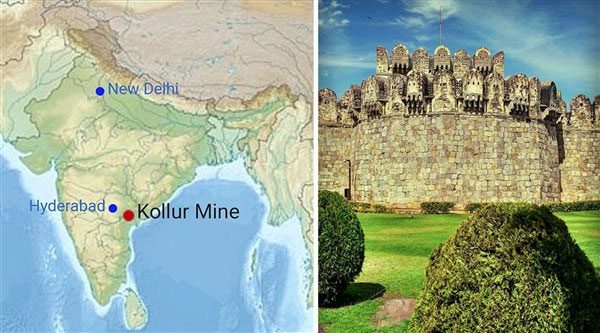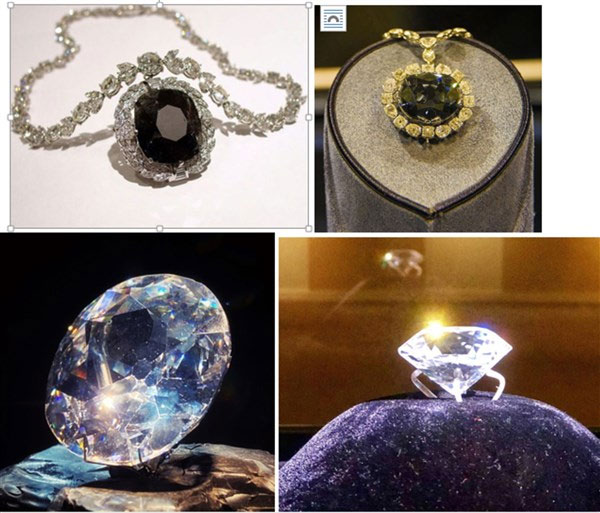Before the discovery of diamond mines in Brazil and South Africa in the early 18th century, India was the only country supplying this precious gem in the world.
Most of the diamonds were mined in Golconda, a small region in present-day Andhra Pradesh and Telangana. Surrounding the diamonds here are many mysterious legends.
The Land of Diamonds
Not far from the capital Hyderabad in Andhra Pradesh, the small town of Golconda was the first capital of the Qutb Shahi dynasty established in the early 16th century. Due to its large reserves of diamonds, Golconda was considered the gem trading hub of India.

The small land of Golconda was once the diamond capital of the world.
Until the late 19th century, Golconda was the largest and best source of diamonds in the world. Golconda became synonymous with wealth, and this landmark was often mentioned with respect by diamond traders and collectors.
The diamonds of Golconda were known to Europeans since the time of Marco Polo (14th century). The French gem merchant Jean-Baptiste Tavernier was one of the few foreigners who traveled extensively across mainland India and visited many gem mines.
In a report about his travels, he described the vastness of the diamond mines, along with the gems found in present-day Tamil Nadu, Maharashtra, Bengal, and Bundelkhand.
Tavernier recounted that he had been allowed to examine a colossal Mogul diamond shaped like half an egg, named after Shah Akbar, the third Mughal emperor of India.
Then the diamond suddenly disappeared. Many believed it was stolen and cut into smaller pieces to hide its origin. According to many scholars today, the 189-carat Orlov diamond, which Russian Empress Catherine often wore, is currently displayed at the Kremlin Armory Museum in Moscow and is one of the diamonds that originated from the aforementioned colossal gem.
Tavernier also mentioned seeing a smooth diamond called the Great Table, kept in a vault in Golconda. It was taken by Persian King Nader Shah (1698 – 1747) during his invasion of India in 1739 and vanished after he was assassinated.
Famous Diamonds

Famous diamonds: From left to right: Orlov diamond, Hope diamond (above), Koh-i-Noor diamond, and Jacob diamond (below).
One of the most famous diamonds originating from Golconda is the Tavernier Blue, which Jean-Baptiste Tavernier purchased in 1666 and later sold to King Louis XIV of France.
This triangular stone weighs 67 carats and has a mysterious blue hue, often worn by the king on a ribbon during ceremonies.
During the French Revolution, after Louis XVI and his family were imprisoned, a furious mob broke into the Royal Treasury, seizing most of the precious gems and diamonds, including the Tavernier Blue. Two decades later, this diamond reappeared in England, recut to a 45-carat stone, renamed “Hope.”
After passing through several owners, it was purchased in 1949 by New York gem dealer Harry Winston, who donated it to the National Museum of Natural History in the United States in 1958, where it remains on display today.
Another famous Golconda diamond that has led to ownership disputes is the Koh-i-Noor, weighing nearly 200 carats. It was originally set on the Peacock Throne, the famous throne commissioned by Emperor Shah Jahan in the early 17th century. The Koh-i-Noor changed hands among various factions in South and West Asia until it came into the possession of Queen Victoria after the British annexation of Punjab in 1849.
After India gained independence in 1947, they requested the British return the Koh-i-Noor to its rightful owners, but the British refused, claiming the gem was legally acquired. Today, it is displayed in the Jewel House at the Tower of London.
In the Crown Jewels collection of the Central Bank of Iran in Tehran, the largest pink diamond in the world, Daria-i-Noor, also mined from the Kollur mine, is preserved.
Originally belonging to the Kakatiya dynasty, it became part of the Peacock Throne, just like the Koh-i-Noor. In 1739, when Nader Shah of Iran invaded Northern India, he ordered a search of the Mughal treasury and took the Daria-i-Noor, along with the Koh-i-Noor and the Peacock Throne.
Researchers believe that the Daria-i-Noor is part of the Great Table diamond that Tavernier described in the 17th century. It may have been cut into two pieces, with the larger part being the Daria-i-Noor and the smaller part being the Noor-ul-Ain diamond, which is currently set on a crown in the collection of the Royal Family of Iran.
Diamonds Leading to Litigation
The famous antique and gem dealer Alexander Malcolm Jacob purchased a 185-carat diamond, which was named after him as the Jacob Diamond, also originating from Golconda.
He then offered it to Mahbub Ali Khan, the sixth Nizam (ruler) of Hyderabad and one of the richest men in the world. The Nizam was required to deposit 2.2 million rupees to receive the diamond shipped from London.
However, when the diamond arrived, he declared he no longer liked it and demanded Jacob return the deposit, which was refused. This led to a court case that shocked India and was widely reported in the international press.
Although the court awarded the diamond to Mahbub Ali Khan and he was not required to pay the remaining amount, the fact that a Nizam had to appear in an English court became a source of shame in the land.
Consequently, the ruler believed the diamond was unlucky and wanted nothing to do with it anymore. He wrapped it in a piece of cloth and stuffed it into an old shoe to hide it.
Mahboob Ali Khan died in 1911. A few years later, his son and successor, Mir Osman Ali Khan, the last Nizam of Hyderabad, found the diamond in his father’s shoe.
Believing the stone to be worthless, the Nizam used it as a paperweight for a long time until its true value was realized. Many decades later, the diamond was purchased by the Indian government from the Nizam’s trust and is now held at the Reserve Bank of India in Mumbai.




















































